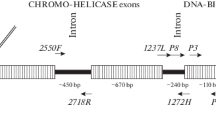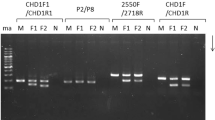Abstract
To manage and conserve endangered Phasianidae species and to study their ecology, behavior, and population structure, sex identification is necessary. A search for the pheasant sex-linked marker (PSL) was carried out by comparing the sequences of chicken sex chromosomes. A triple-primer PCR approach was established in the present study based on a novel PSL for the sex identification of Phasianidae birds. The triple-primer system amplified a 202-bp PSL-W-specific fragment in female Phasianidae birds, whereas there is a 107-bp PSL-Z-specific fragment in the both sexes, thus making the female distinct. We also found a 102-bp AT-rich repeat sequence inserted into the PSL-W-specific region in Tetraophasis szechenyii generating a ∼300-bp PSL-W fragment in females. The sex of 11 Phasianidae species was distinguished clearly by the triple-primer PCR approach indicating that this method is both quick and reliable and can be easily applied to a wider range of Phasianidae species. Due to the relatively small size of the amplification products, the triple-primer PCR approach can also be applied to noninvasive samples such as feathers.




Similar content being viewed by others
References
Bush KL, Vinsky MD, Aldridge CL, Paszkowski CA (2005) A comparison of sample types varying in invasiveness for use in DNA sex determination in an endangered population of greater Sage-Grouse (Centrocercus uropihasianus). Conservat Genet 6:867–870
Dawson DA, Darby S, Hunter MF, Krupa AP, Jones LL, Burke T (2001) A critique of avian CHD-based molecular sexing protocols illustrated by a Z-chromosome polymorphism detected in auklets. Mol Ecol Notes 1:201–204
Ellegren H (1996) First gene on the avian W chromosome (CHD) provides a tag for universal sexing of non-ratite birds. Proc Biol Sci 263:1635–1641
Ellegren H, Sheldon BC (1997) New tools for sex identification and the study of sex allocation in birds. Trends Ecol Evol 12:255–259
Elliot DG (1872) A monograph of the Phasiandae [M]. New York, pp 1–2
Fridolfsson AK, Ellegren H (1999) A simple and universal method for molecular sexing of non-ratite bird. J Avian Biol 30:116–121
Griffiths R, Daan S, Dijkstra C (1996) Sex identification in birds using two CHD genes. Proc Biol Sci 263:1251–1256
Griffiths R, Double M, Orr K (1998) A DNA test to sex most birds. Mol Ecol 7:1071–1075
Griffiths R, Korn RM (1997) A CHD1 gene is Z chromosome linked in the chicken Gallus domesticus. Gene 197(1–2):225–229
Harrison GJ (1978) Endoscopic examination of avian gonadal tissues. Vet Med Small Anim Clin 73:479–484
Hu RY, Li ZK, Ding XY (2005) Progress in the investigation of avian sex determination and sex identification. Yi Chuan 27:297–301, in Chinese with English abstract
Jones DM, Samour JH, Knight JA, Finch JM (1984) Sex determination of monomorphic birds by fibreoptic endoscopy. Vet Res 115:596–598
Keane A, Brooke MDL, Mcgowan PJK (2005) Correlates of extinction risk and hunting pressure in gamebirds (Galliformes). Biol Conservat 126:216–233
Itoh Y, Ogawa A, Murata K et al (1997) Identification of the oriental white stork, Ciconia boyciana, by the polymerase chain reaction based on its sex chromosome-specific DNA sequence. Genes Genet Syst 72(1):51–56
Itoh Y, Ogawa A (2001) Identification of the sex of a wide range of carinatae birds by PCR using primer sets selected from chicken EE0.6 and its related sequences. The American Genetic Association 9:2315–2321
Kahn NW, John JS, Quinn TW (1998) Chromosome-specific intron size differences in the avian CHD gene provide an efficient method for sex identification in birds. Auk 115:1074–1078
Rudnick JA, Katzner TE, Bragin EA, Eugenerhodes O Jr, Dewoody JA (2005) Using naturally shed feathers for individual identification, genetic parentage analyses, and population monitoring in an endangered Eastern imperial eagle (Aquila heliaca) population from Kazakhstan. Mol Ecol 14:2959–2967
Sambrook J, Russell DW (2002) Molecular cloning: a laboratory manual, 3rd edn. Science Press, Beijing
Shin JH, Kim H, Lim D, Jeon M (2006) Analysis of chicken embryonic gonad expressed sequenced tags. Anim Genet 37:85–86
Taranenko NI, Potter NT, Allman SL, Golovlev VV et al (1999) Gender identification by matrix-assisted laser desorption/ionization time-of-flight mass spectrometry. Anal Chem 71:3974–3976
Woodage T, Basrai MA, Baxevanis AD, Hieter P, Collins FS (1997) Characterization of the CHD family of proteins. Proceedings of The National Academy of Sciences. 94:11472–11477
Zou F, Yue B, Xu L, Zhang Y (2005) Isolation and characterization of microsatellite loci from forest musk deer (Moschus berezovskii). Zoolog Sci 22:593–598. doi:10.2108/zsj.22.593
Zhou Xin, Nan YANG, Bisong YUE, Jianghong RAN, Jing LI (2008) Sex identification in buff-throated partridge using PCR method. Sichuan Journal of Zoology 27(4):645–647
Acknowledgements
We thank Guo Cai and Jianghong Ran for the DNA samples, Xiuyue Zhang for the valuable help throughout this project, and Emily king for the English language help. This research was funded by National Natural Science Foundation of China (Grant No. 30870245).
Author information
Authors and Affiliations
Corresponding author
Additional information
Communicated by C. Gortázar
Data accessibility
DNA sequence is from Genbank accessions JF798508.
Wenqing Li and Fei Xue contributed equally to this work.
Rights and permissions
About this article
Cite this article
Li, W., Xue, F., Li, L. et al. A triple-primer PCR approach for the sex identification of endangered Phasianidae birds. Eur J Wildl Res 58, 289–294 (2012). https://doi.org/10.1007/s10344-011-0576-0
Received:
Revised:
Accepted:
Published:
Issue Date:
DOI: https://doi.org/10.1007/s10344-011-0576-0




